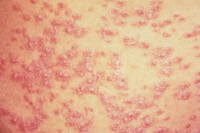Guttate Psoriasis is a very common form of Psoriasis, which I encounter very often in both my The Woodlands dermatology and Conroe dermatology offices. The lesions of Guttate Psoriasis resemble the classic Plaque Type Psoriasis but they are very small “raindrop” like lesions with significantly less scale that predominantly occurs on the trunk and extremities. The lesions in Guttate Psoriasis are usually more pruritic (itchy) than in other forms of Psoriasis. Children and adults under age 30 are most prone to developing Guttate Psoriasis. An infection with Streptococcus, “strep throat” is the most likely trigger for the development of Guttate Psoriasis, but other infectious causes are Chickenpox, Rubella, and Roseola. Nail involvment is unlikely but can occur as in other forms of Psoriasis. I typically check an Antistreptolysin titer (ASO) to evaluate for Streptococcus infection. If Streptococcus infection is found, patients can be treated with antibiotics to eliminate the trigger. Guttate Psoriasis may be a one time occurence of Psoriasis or it can herald a lifetime of battling this disease. Occasionally, patients with long standing Psoriasis may have an episode of Guttate Psoriasis. In most patients, Guttate Psoriasis is self-limited and may resolve in one to two months without any treatment. Topical steroids benefit most patients with Guttate Psoriasis and natural sunlight can be very effective for this form of Psoriasis as long as patients limit their sun exposure and prevent sunburns.
March 13, 2011




